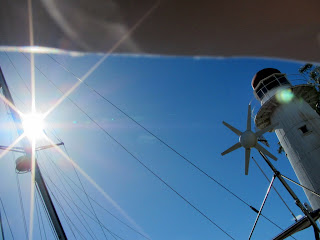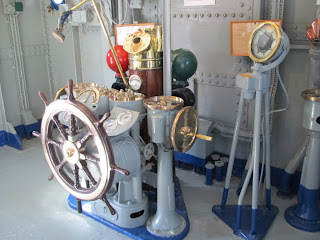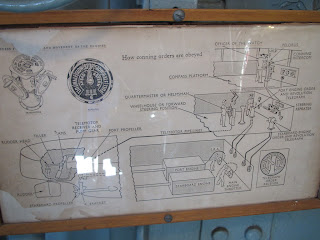The Queensland Maritime Museum is located on the southern bank of the Brisbane River just south of the South Bank Parklands precinct of Brisbane, and close to the Goodwill Bridge. AUS 8 for an adult entrance fee. Operating hours 9.30 am to 4.30 pm (last entry 3.30 pm).
The museum was founded in 1971 and contains a two level exhibition building presenting historic sailing ship models together with merchant shipping from early cargo ships to modern container ships, tankers and cruise liners.
On display, this is a model of Hatsheput, early Egyptian vessel made out of papyrus in the early years. The name actually comes from the fifth pharaoh of the eighteenth dynasty of Ancient Egypt.
This is the HMS Endeavour. It was a British Royal Navy research vessel commanded by Lieutenant James Cook on his first voyage of discovery, to Australia and New Zealand from 1769 to 1771.
Some of the models were made from a famous model maker which I could not recall his name. He donated most of his work to the museum. This is one of the ship he made with a lot of cannons.
This is one of the steam ship he made also. I am very impressed with the details he put into the boat, he must had put a lot of effort and time into in.
Aiyae, Captain, shall we turn left or right.....Er port starboard? (By the way, the wheel cannot be rotated, so we just sail straight forward. Lolx)
The museum also includes a library that stocks documents, pictures and other relevant artifacts relating to maritime history. There are several maps that show how early navigators created accurate charts.
I learned some facts on the Sirens, were three dangerous bird-women, portrayed as seductresses who lured nearby sailors with their enchanting music and voices to shipwreck on the rocky coast of their island. One of the stories mentioned that the sailors put bee wax in the ear and tie their captain to the ship to sail out for safety. You can find out more on http://en.wikipedia.org/wiki/Siren
There was a wall on the woman's achievement in the sea. Apparently being a pirate also qualify one. This is an artist impression of a woman pirate, I can't remember her name. I don't know if she will smoke you will the gun or her clothing.
There were also a great display of instruments used for navigation in the museum. This is the Pelorus, A compass for navigation over the seas.
This is the sextant, an instrument use to measure the angle between two visible objects. They use it to help pin point the ship's location by finding the position line on a nautical chart by referring to the horizon and the stars in the sky.
Can you imagine sailing in the sea in a Thunderstorm? I will definitely puke. Sailing in the sea can be very treacherous. I like this oil painting which was on display.
Since it is so treacherous, some of the ship did not made it through. So they ended up in the sea bed. Apparently, there is a map for all the graves of some famous ships.
This is a bunk inside the ship. It is compact, but it still manage to fit 4 beds with a basin and cabinet.
This is the Great Queensland list of passengers in 1874. I am not sure whether this is the original copy or a duplicated one.
It is very amazing to see this collection of culinary ware. Most of them are made out of sea shells, even the buttons.
They even have a light house inside the museum. It is rotating but not blinking with any light. If there is I think most of the visitors will go blind already.
There is also a showcase on how the equipment used to make ropes, rigging them and sailor knots. I would really like to learn how to make some strong knots one day from a sailor.
This is a model of a light house structure with only the skeletons.
I found this macho man entangled in his own knot. I wished I could help free him.
This is the Pink Lady, the latest acquisition of the Museum. Queenslander Jessica Watson made history as the youngest person to sail solo around the world in 2009/10.
I think this is what she might see in a bright sunny day in the open waters, minus the light house.
Time for some war action. This is MK9 surface launched torpedo.
Welcome aboard the Diamantina – (nominated as a Queensland Icon) a Royal Australian Navy frigate built in Queensland and commissioned in 1945.
You get to tour the ship from stem to stern and from bridge to engine room. It is a very humongous warship, so you can take your time an fully explore it, or play around. hehe....
I first check out all the artillery and fire power. Unfortunately, I was not able to sit on the gunner's position and spin around because the access to it was blocked.
There are so many turrets on the ship. This is a view from one of the deck. We are sailing towards a bridge that we cannot cross.
I believe these are the depth charges, where they drop it to kill the submarines. There are more barrels stored on the ship deck.
This is where the commander of the ship will navigate. I played with the PA system. I can hear myself but I am not sure other visitors around the ship can hear me making some funny noises there.
This is how they communicate in the ship I believe. Visitors are able to visit most parts of the ship and experience living conditions on a World War 2 naval vessel.
The Engine Room is in pristine condition and is accessible to visitors. I guess it must be pristine because there is no wear and tear while the ship just sits and dock in the dry dock.
You get to explore about 2 levels of the war ship. this is the cramped quarters in which the crew slept and ate their meals. Hammocks were replaced by bunkers in the later years.
This is the Pelorus compass and other navigation equipment room. There are a variety of exhibitions within the ship which portray the ship's role and other naval memorabilia.
"Be Aware" Don't play play. These are some wood badges from different war ships that went into service.
I guess this what it would look like when the war ship goes to war in a rough sea.
I hope that when they go to war, the toilet is not locked up and out of service.
At the wharf, you can find the powerful steam tug Forceful. Built in 1925 Forceful served the port of Brisbane for 45 years, being the last coal fired tug in operation.
Upon being donated to the Museum, she was preserved as a working vessel, making regular trips down the Brisbane River to Moreton Bay. However, the cost in maintaining her sea-worthiness has become beyond the Museum's recources and she will be maintained as a floating exhibit.
Well, if you are interested. Grab a spinach and fuel yourself to visit the Queensland Maritime Museum.








































No comments:
Post a Comment